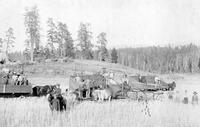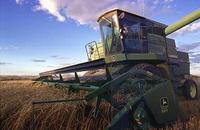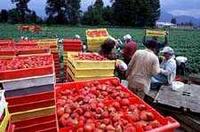Agriculture
AGRICULTURE is the third largest resource industry in BC after the FOREST INDUSTRY and mining, despite the fact that only 3% of the land area is suitable for farming—the smallest percentage of arable land of any province except Newfoundland. Since 1973 most of this land has been protected from non-agricultural use by the AGRICULTURAL LAND RESERVE. More than a quarter of BC's farms are concentrated in the lower FRASER VALLEY, the centre of DAIRY FARMING and BERRY, vegetable, poultry, pig and MUSHROOM production. The valley has the longest frost-free growing season in Canada. Cattle raising is centred around KAMLOOPS and in the CARIBOO and CHILCOTIN (see CATTLE INDUSTRY). TREE FRUITS are concentrated in the THOMPSON R and OKANAGAN valleys, where another 25% of the farms are located. The PEACE R area accounts for 86% of BC's grain production. Other significant agricultural areas are southern VANCOUVER ISLAND and parts of the KOOTENAY.
The first crops were grown at NOOTKA SOUND in 1790 by the Spanish garrison posted there. Later the HBC began raising crops at some of its trading posts and established the first agricultural settlers on land near VICTORIA in the 1850s. From these modest beginnings, agriculture has grown into an industry accounting for 33,000 direct jobs and many more in processing and manufacturing. In 2006 there were 19,844 farms in BC. Between 2001 and 2006, the amount of land devoted to farming increased by 9.6%, the largest increase of any province. In 2005 farm cash receipts totalled $2.6 billion. The agricultural industry produces 200 different commodities. The marketing of several of them is supervised by provincial marketing boards. There are 8 such boards or commissions in BC, regulating sales of vegetables, turkeys, milk, hogs, eggs, CRANBERRIES, chickens and broiler hatching eggs. Individual commodity boards are themselves regulated by the Farm Industry Review Board. Organic farming is a growing sector of the industry, with 16.3% of all BC farms selling organic fruit, vegetables or meat in 2006, well above the national average of 6.8%. (Organic farms do not use synthetic fertilizers, artificial pest controls or genetically modified products.) There are grocery chains that specialize in organic products, and restaurants are increasingly serving organically produced food.
Among the most important livestock products, after cattle and dairying, are:
Poultry and Eggs. There are about 4,460 farms producing chickens in BC, producing 18.3 million birds a year. Another 3.1 million laying chickens are kept by commercial egg producers. There is also a smaller market for turkeys, about 822,000 of which are raised annually, mainly in the Fraser Valley.
Hogs. There are 817 BC producers, once again mainly in the Fraser Valley, producing 135,826 animals a year for slaughter. In 2004 pigs had a farm gate value of $47 million. Local producers account for 25–30% of all the pork eaten in BC.
Sheep. There are about 61,000 sheep in BC, raised both for their wool (about 85 tonnes a year) and meat.
Goats. A small number of goats (13,091 in 2006) are raised for their milk (used to drink and make cheese), meat and wool.
Exotic livestock. This category includes llamas, which provide wool; emus and ostriches, raised at this point only to provide breeding stock; and reindeer, raised at a very few locations in the Peace R for meat.
Important plant crops include mushrooms, cranberries and other berries, tree fruits and vegetables. Another significant sector is floriculture, the production of cut flowers and potted and bedding plants in both greenhouses and fields. This industry includes about 500 producers, 90% of whom are located in the lower Fraser Valley within a 2-hour drive of Vancouver. A related industry is the growing of nursery crops, including trees, shrubs and other plants. BC is the second-largest producer of nursery stock in Canada, producing 32% of national sales. In 2004 floriculture and nursery crops taken together accounted for $465.3 million in revenue for producers, making it the third most valuable agricultural sector after dairy farming and poultry production.



